October has come and gone, and we have a new batch of Japanese learning resources for you, just in time for the ghost and goblins to go back from whence they came.
Well, sort of…
To be honest, this month felt like a disappointment, especially when compared to last month, when we got amazing heavy-hitters like LingoDeer and Bunpro.
There are a few new resources we want to mention this month, but keep in mind none of them are really up to our normal standards. They may still work for you, but most are either very new or need a ton of work to get where they need to be.
- Duolingo: Japanese (Browser)
- Speak and Read Japanese: Fun Mnemonic Devices for Remembering Japanese Words and Their Meanings
- RomySensei
- Kanso
- Super Mario Odyssey: Japanese
- Rikaichamp
Duolingo: Japanese (Browser)
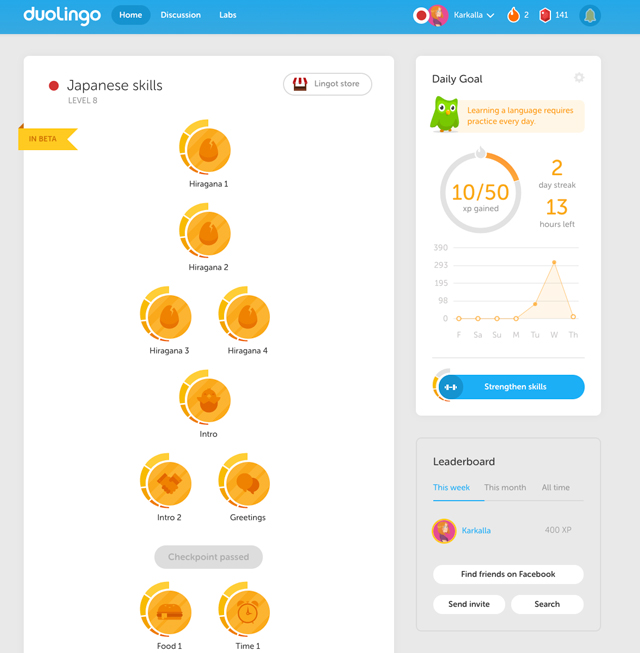
While it's still technically in beta, Duolingo users can now learn Japanese on their browsers, not just on the iOS or Android apps. Many people, myself included, were excited to see what Duolingo had done to bring Japanese learning to browsers.
However, the program still needs a mountain of work.
For those who aren't familiar with Duolingo, it's a free resource that teaches the basics of different languages through gamification, repetition, and intuition-based learning.
Words and grammar aren't taught, so much as reinforced through usage, making Duolingo great for some, and not so great for others (especially if you want to learn more than the bare minimum for basic communication). And there are no limits on the speed you can learn. If you want to push through everything on the site in a single day, you can (as long as you have a few hours free). You can also choose to test out of sections, if you're that advanced.
Now, for the browser Japanese content there's new info for those of you who haven't looked at the Japanese course since the app version was first released. This brings some good and some bad.
You have the ability to turn off the "word bank" where you select your translated answers, and instead type them in. This is a great feature because it means you're recalling the information from your brain, instead of just guessing the most likely answer from a list in front of you. All apps should force you to type.
However, the keyboard does not automatically change to the input needed, meaning you need to quickly switch from English→Japanese→English yourself.
When you don't have Duolingo's model to follow, this reveals a few flaws in their system. The most glaring I found is if you and your IME know a kanji, sometimes the system doesn't, marking you wrong for obviously correct answers.
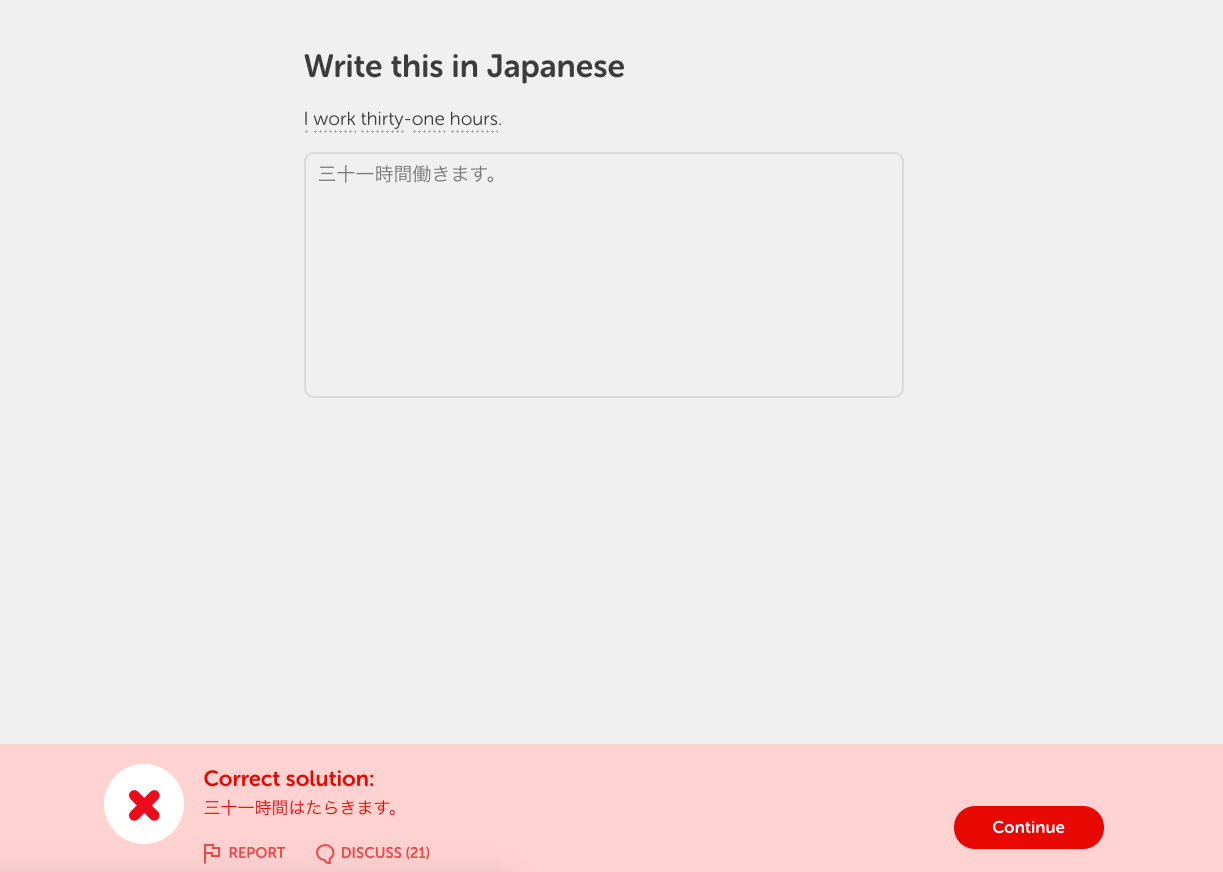
I wrote:
三十一時間働きます。
And they said the correct answer was:
三十一時間はたらきます。
Which is literally the same sentence, but without the kanji for 働く (to work). This is an error, because not all sentences mark you wrong for this. Sometimes it works, sometimes it doesn't. Users shouldn't be penalized for knowing their kanji.
I point this out because Duolingo usually does an amazing job of accounting for typing and spelling variations. This comes from many users testing and reporting errors, helping them improve and change the way they grade your answers. However, this issue really shows they're still in beta.
Another complaint: the audio was either incorrect or missing from most of the content. The best thing about Duolingo for other languages is you have the ability to listen to native recordings, type what you hear, and even start speaking into your mic. And the system can usually recognize it!
Many people, myself included, were excited to see what Duolingo had done to bring Japanese learning to browsers.
However, the program still needs a mountain of work.
While there is more audio, Duolingo's Japanese course still doesn't have the voice recognition option. And there are many issues with the audio they do have. Simple hiragana characters like す and る are completely cut off. They sound like someone hissing (す) or someone choking before they could finish speaking (る).
And while they fixed the pesky は particle always being read as "ha," there are still errors like 中 (ちゅう) being read as なか in the wrong context, and audio volume being all over the place.
So while this course has been highly anticipated, it just isn't ready yet, even as a beta product. I think you could even argue the iOS version is more polished than this one, which is a big letdown since they've been working on this one much longer.
I hope Duolingo Japanese improves as it moves through beta testing, but for new learners who have never used anything else, I advise against it, at least for now.
Everyone else, please use the site and report the heck out of all of those errors. Help them make this the product it should have been!
Speak and Read Japanese: Fun Mnemonic Devices for Remembering Japanese Words and Their Meanings
This new book (with a very long title) is made to teach Japanese vocabulary using mnemonics. Hey, we know a little bit about mnemonics! In fact, a lot of what's written in this book has been covered by Tofugu over the years, so you know this methodology is spot on.
The book itself is a little over a hundred pages and focuses solely on vocabulary words and mnemonics to learn their readings and meanings. Each entry is fairly short, presenting the romaji, kanji, hiragana, and meaning. Then it gives a short (usually one sentence to a paragraph) explanation of the mnemonic.
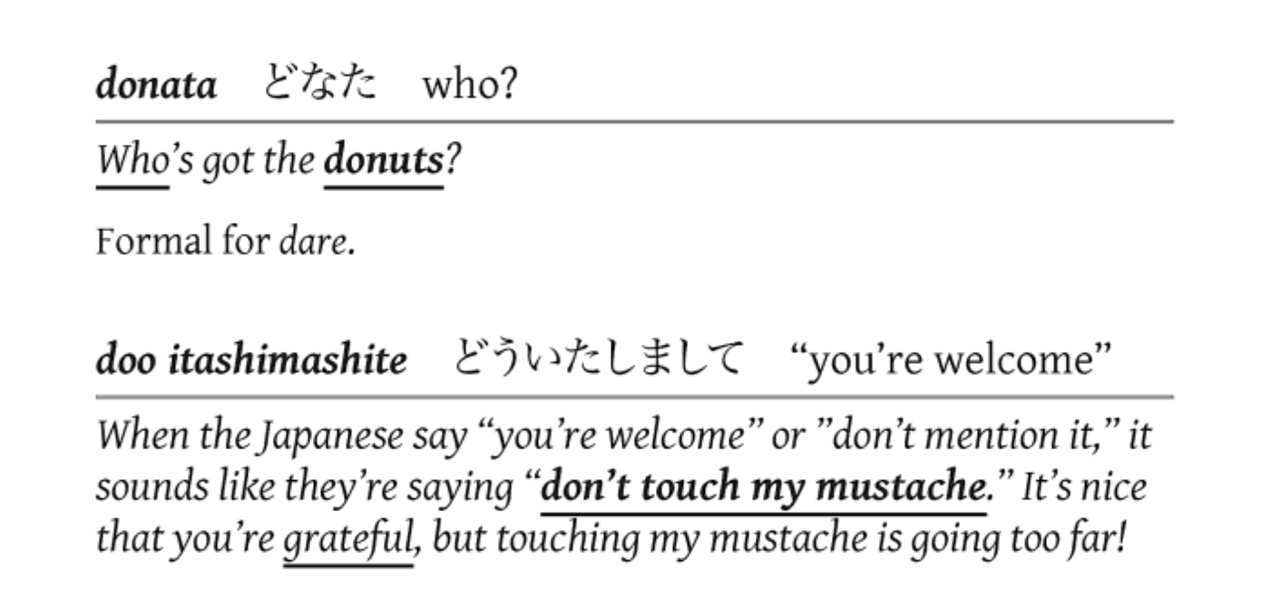
The mnemonics are basic, and they're usually the first thing most people think of when trying to connect sounds to meanings. Some entries break down the meaning of the kanji behind the word; others go further into the radicals of those kanji as well.

But not all entries get this level of attention, making a lot of them feel like unfinished thoughts. It's as if the author wanted to go into radicals and kanji first and then vocabulary with mnemonics, but was forced to limit himself—which makes sense if you're trying to put all that information into a physical book. But the book is quite short, making that line of reasoning weak, at best.
Basically, if you're looking for a small book you can pick up to help with basic Japanese vocabulary through mnemonics, this will do that. It doesn't cover a ton of vocabulary, but it does cover some of the most common words you'll encounter through your first year or two studying Japanese. But this content, and much more, can be found for free online through sites like Memrise, so this is a limited product compared to something more approachable like a site designed around mnemonics.
RomySensei

A promising new site called RomySensei aims to teach you more about the Japanese words you're learning. Romy Ellis is a Japanese teacher who realized that when she taught the basic etymology behind the words her students were learning, they learned faster and remembered them longer. So she started a new site to teach information that usually requires a teacher, native speaker, or extra online researching.

The site is still in its infancy, with only ten words at the end of October, but it has a simple design and I could see it becoming a very useful resource with more time and attention. Each entry (so far) is for a word that has a bit more to it than meets the eye. The example above, 教育ママ, is one that almost all exchange students have heard, but may not come up in an American classroom setting. She goes into the meaning, the background, kanji, and usage with her own example sentences and English translations. Kanji details link straight to popular J-E dictionary Jisho.org and furigana for everything on the site can be toggled on or off easily in the top righthand corner.
She also has a newsletter to notify you when new words are added and probably to help her improve as time goes on.
I really like this idea and the simplicity of this resource. I think with time it could become extremely valuable to self-learners who don't have access to native Japanese speakers or teachers, so please give Romy-sensei your support!
Kanso
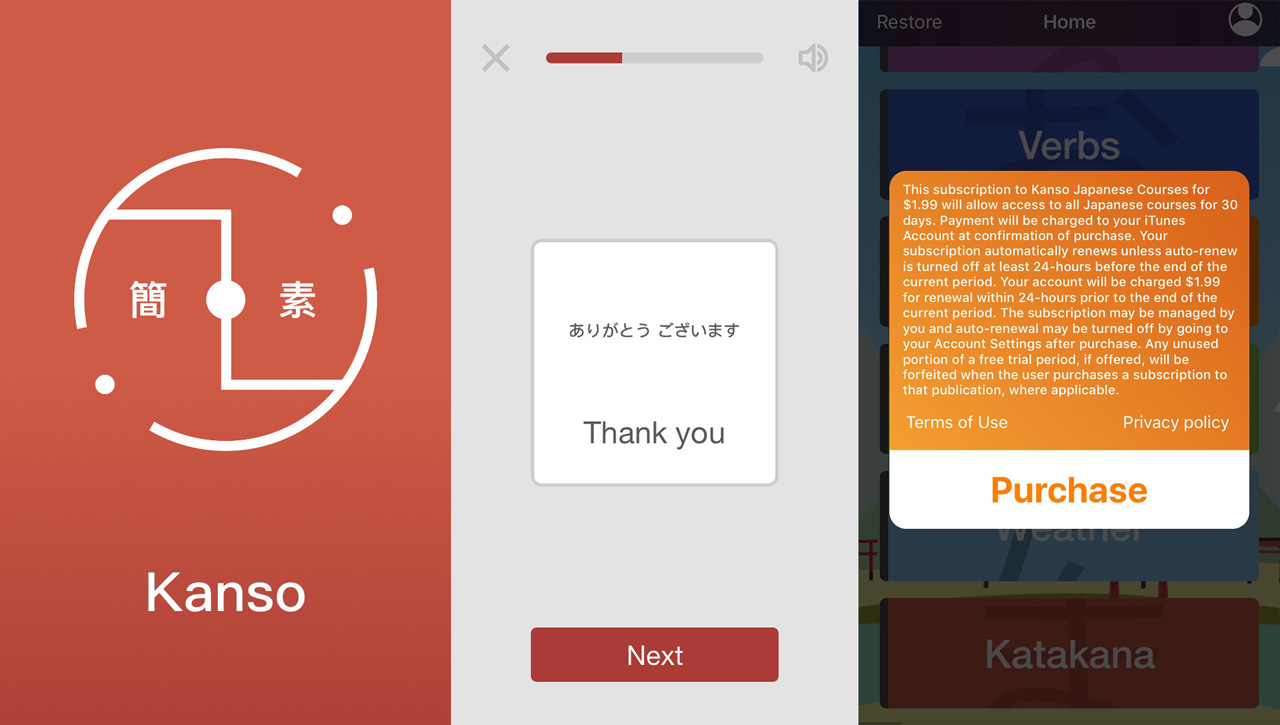
An app claiming to be "a better way to learn the Japanese language" popped up for iOS this month, called Kanso (簡素), meaning "simplicity."
The app is definitely simple. It teaches a few basics, like hiragana, katakana, and some vocabulary. The teaching style is similar to Duolingo and LingoDeer, but it lacks any pronunciation audio. The keyboard automatically switches between Japanese and English based on what it's asking, which is nice. But there is considerable lag when waiting for answers to be accepted. If you go too fast, like I did, then it throws a bunch of "correct" messages at the top of the main page for a while.
The app is definitely simple. It teaches a few basics, like hiragana, katakana, and some vocabulary. The teaching style is similar to Duolingo and LingoDeer, but it lacks any pronunciation audio.
There is no indication as to when you've finished a lesson, how well you did, or even that you completed it. And everything beyond hiragana and a few greetings is blocked behind a paywall of $1.99 a month.
Another issue I noticed, other than the attempted cash grab, is that there are spaces between Japanese words, which is a huge no-no.
Kanso lives up to its name, at least. This app is extremely simple and it doesn't have much to offer yet.
Again, this is a very new app so there's room for improvement. The first, much-needed improvement is teaching something meaningful before asking for payment. That way, users can get a sense of what Kanso offers before getting locked into a monthly bill.
There also seems to be more work put into the documentation that protects Kanso's rights than there is on the quality of teaching, which is disheartening.
Super Mario Odyssey: Japanese

Oh-a boy! Nintendo is at it again with another game from a classic series you can play in Japanese right now. Remember how frustrating region locks used to be? Yeah, me too. Let all other game companies look at Nintendo as a shining example of what they should be doing.
Anyway, スーパーマリオ オデッセイ, or Super Mario Odyssey in English, is out now for the Switch and can easily be played in Japanese. Even easier than Breath of the Wild, which, if you remember, required you to change your entire Switch to Japanese in the settings. This game, however, can be changed completely to Japanese from the in-game menu. And while the game itself has no spoken English or Japanese, other than the occasional "Mario" or "Oh no" sound, there's a decent amount of text. That text is useful to you, dear Japanese learner, for some pretty interesting reasons:
- As you may have already noticed, if you've been playing the game in English, there are a lot of facts stated in this game. Even the moons you collect on your journey have factual descriptors for where you found them and how, instead of silly fantasy names. That's some practical Japanese right there!
- The clues and puzzles aren't in the language, but the stages themselves. NPCs will tell you exactly what's wrong. Things like:
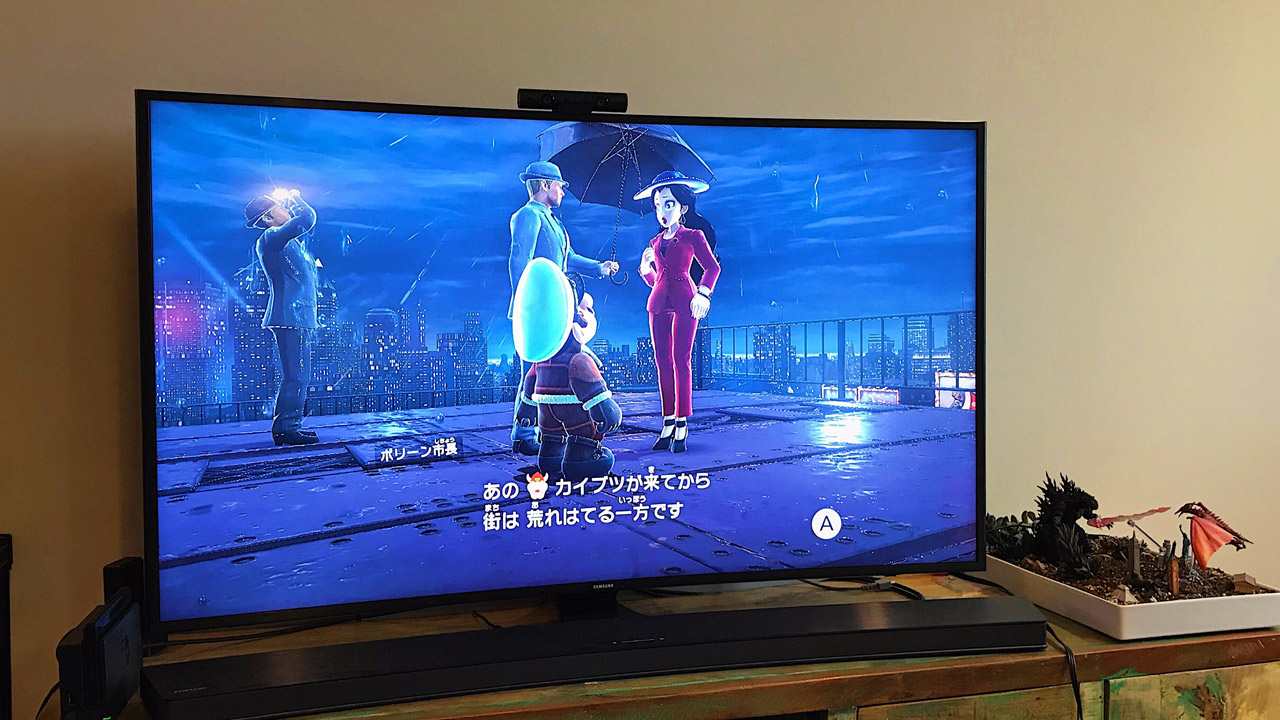
- あの[BOWSER]カイブツが来てから街は荒れはてる一方です
- The city's just been getting worse since that monster Bowser got here.
And awesome ones like this, that you'll miss if you're playing only in English.
- ワガハイは結婚式の準備で忙しいのだ!マリオは家に帰ってキノコでも食べてろ!!
- I'm busy planning my wedding! Go home and eat some mushrooms or something!!
They're just stating facts, not trying to get you to solve tongue-twister riddles to unlock a cave entrance. This is Japanese you can actually use!
And there's furigana above most of the kanji. Though we aren't huge furigana advocates here at Tofugu, in this case we think it's okay. Here's why: this game is great for upper-beginner and intermediate Japanese learners to start using what they know. Thanks to the basic language, simple context clues, and furigana, most people will be able to go straight into playing and understanding this game without it being more than +1 their current level. This is important for progressing.
Also, the game is cute and you get to see Mario's nipples. You're welcome.
Rikaichamp

I hope you've all heard of Rikai, the browser extension that's made looking up Japanese kanji, vocabulary, and grammar online much easier in the past decade. If not, here's what it does:
Using the add-on, you're able to hover over Japanese text and see dictionary definitions through a popup. That's basically it, but it saves you from keeping other tabs open to constantly to look up new words, kanji, and grammar. Pretty useful!
Unfortunately, as new versions of browsers are released, sometimes extensions can't keep up, which seems to happen sometimes with the original Rikaichan on Mozilla Firefox.
Rikaichamp works as a lightweight version of Rikaichan (similar to the Google Chrome version called Rikaikun) that works in Firefox 57. It doesn't have all the functionality of the original, but if you've been struggling without a working Rikai, you can use this instead. But struggling without extensions like this one is a good sign you're using it as a crutch. It's best to stop using Rikai as soon as possible or not at all.
Update: RikaiChamp has been renamed to 10Ten Japanese Reader, and has immensely improved in functionality since our original writing. Check it out!
That's all from the spookiest month of the year. 🎃 If you think we missed something or you find a new resource next month, let us know on Twitter (@tofugu) or email us at hello@tofugu.com. We're always on the lookout for new, innovative tools to help all Japanese learners reach their goals. See you next time! 👻 👹
